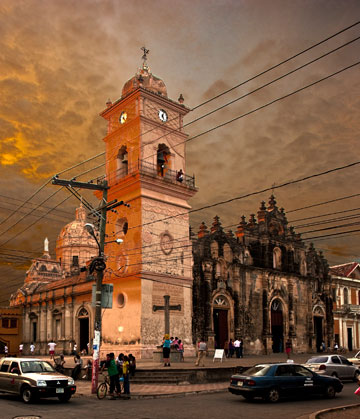
Coming up with a successful recipe for a vacation isn’t an easy thing to do, especially if you’re an intrepid traveler. Let’s say you’ve overdone Europe; explored Africa, India, and China; and have spent too much time and money in expensive resorts and well-located “tweeners” all over the globe. You’re more than willing to trade in another overpriced trans-Atlantic cruise for a chance to discover a country before international investments obliterate the soul of the emerging nation’s tourism effort.
Located between Honduras to the north and Costa Rica to the south, Nicaragua is now endorsing tourism instead of civil war. Daniel Ortega and the Sandinistas may be back in power, but the country’s tourism department has hired Murphy O’Brien, a high-profile Los Angeles-based public relations firm that represents luxury resorts, real estate developments, lifestyle brands, spas, and restaurants all over the world to promote Nicaragua as the new Central American hot spot.
Last November, Murphy O’Brien organized its first official press trip to Nicaragua, and I, along with a handful of travel journalists, jumped at the chance to visit a country attempting to transform its image from an unsafe banana republic to one that serves banana daiquiris to upscale visitors.
The unique topography of Nicaragua creates a variety of options for tourism. The Atlantic coastal plain in the east rises to the central interior mountains before the land drops down to the Pacific coastline.
Between the mountains and the Pacific is the sparsely populated Caribbean lowland. This region, also referred to as the Mosquito Coast and named for the Miskito Indians who originally inhabited the coast, contains the largest expanse of tropical rain forest north of the Amazon in South America. Travel through the Nicaraguan rain forest by car is not a realistic option. (Well, not unless you have a good four-wheel drive vehicle and a few weeks to make your way from one side to the other.) The best way to experience this isolated area is to take a short flight from Managua to the small airport in Bluefields and set out from there. Not into rain forest exploration? Big Corn Island is only 50 miles off the coast. Once a haven for pirates, this remote island with several rustic, chic lodges, is reachable by plane. Big Corn Island is surrounded by smaller, far-flung islands such as Little Corn Island. If you really want to escape from your hectic life and don’t mind simple accommodations, any of these spots could be your fantasy island. There are no cars—just golf carts, scooters, and a small local bus. And plenty of hammocks.
The north central section of Nicaragua is mostly rugged mountainous terrain. If you enjoy archeology, visit El Bosque Cave, where ancient animal and human remains date back more than 30,000 years. If you’re a birdwatcher or nature enthusiast, check out the Biosphere Reserve of Bosawás, a UNESCO site filled with more than 700 bird species, pumas, jaguars, and too many insect species to count. Most of Nicaragua’s coffee plantations are located in this area, and many, like Selva Negra, offer accommodations such as cabins and cottages in the woods, small sustainable restaurants, and just about anything else you need to stay for a few days.

Managua, the capital of Nicaragua, is worth a short visit, but the city doesn’t have the unique character of the smaller colonial cities such as León and Granada. Two major earthquakes (1931, 1972) destroyed most of Managua’s older buildings, and modernization has been stunted by decades of civil war. Managua does have an interesting historic center, where a visit to the Plaza de la República, also known as José Dolores Estrada Park, is a must. There you’ll find the memorial to Sandinista commander Carlos Fonseca Amador, the ruins of the Catedral de Santiago, and the Palacio Nacional de la Cultura. Most of the city’s cultural events take place at the Teatro Nacional Rubén Darío, named after one of the most famous poets of Latin America. There are several large food markets and plenty of street food venders around the city’s parks, but the popular Zona Hippos is where you’ll find the upscale restaurants and nightclubs.
After one night in Managua, our team headed south and west to San Juan del Sur, a town on the Pacific coast that is a popular vacation spot for Nicaraguan families and surfers from all over the world. The good news is that the hotels and restaurants in this sleepy little spot with fabulous beaches are less than half the price of those in nearby Costa Rica. The bad news is that San Juan del Sur and the luxurious Piedras y Olas Hotel have both been discovered by Hollywood’s favorite surfer, Matthew McConaughey. “Oh, yes,” says the bellman who helped me maneuver the rocky steps to my hillside villa. “Mr. McConaughey stays in this room every time.”
I found no trace of the How to Lose a Guy in 10 Days star, but I did find a gorgeous two-story, two-bedroom villa with a huge, fully equipped kitchen and a terrace with a sweeping view of the crescent-shaped bay below. Later that evening, we wandered the streets of San Juan del Sur and peeked into an eclectic collection of eateries, bars, and businesses on our way to dine at El Bambu, a surf-bum chic restaurant that serves everything from sushi (didn’t go there) to spaghetti and meatballs.
The next morning we boarded a yacht and cruised north along the coast to tour Guacalito de la Isla, a $350 million luxury gated community and boutique hotel project that has just broken ground. Located just 90 miles from Managua, Guacalito is set to be Nicaragua’s first “six-star sustainable development project” on Nicaragua’s Emerald Coast. Currently there are only a few roads and a lovely sales office on the site, but the land plots, all with ocean views, are going fast. Could Nicaragua be close behind?
Later we toured Morgan’s Rock Hacienda and Ecolodge, an exotic hotel with a private beach. The bungalows are scattered in the forested hillside filled with gregarious howler monkeys and colorful birds. The hotel is dedicated to tree farming and conservation. Guests are encouraged to gather their breakfast eggs at the on-site farm. You could spend a week there surrounded by beach and forest and never know you were frolicking 20 minutes from San Juan del Sur. Of all the properties we toured in Nicaragua, Morgan’s Rock is the one I’d choose for a lazy holiday.
We left Morgan’s Rock and took the long—and I mean long—way to Granada. Our goal was to tour Punta Teonoste, a nature beach lodge and spa north of San Juan del Sur. Our only option, however, was to traverse a series of back roads, which is a kind description for the tire-popping, pothole-laden trails we endured for two hours.
In hindsight, I’m pleased that we went so far off (on?) the beaten path. The journey allowed us to see sights of Nicaragua that most tourists do not witness. Small villages of tin-roofed houses huddled around community water wells were scattered along the roads. Most of the tiny villages were without electricity, and dogs, pigs, chickens, and children roamed free. This lack of infrastructure is one of the many impediments to foreign investors. To reach many of the remote beaches on the Pacific coast, though, a long, bumpy ride is your only option. Hopefully Ortega’s current government, which has made tourism development a top priority, overcomes political tensions and concentrates on nurturing the growing ecotourism industry. Until then, be prepared to stop for crossing goats.
Eventually, we reached Punta Teonoste, an eco-conscious property nestled on a long, private, white sand beach. There we found 16 thatched-roof bungalows, each equipped with lovely outdoor bathrooms and showers. You won’t find phones or TV, but there is a small spa, French restaurant, a sparkling pool, and a private turtle hatchery on-site.
We hit Granada just before sundown and headed through the cobbled streets to Parque Central, the vibrant city square, to devour some street food. There we sampled our first nacatamal—corn and butter dough filled with pork, rice, potatoes, tomatoes, onion, and sweet pepper that is wrapped in plantain leaves and steamed. Gnawing on ears of roasted corn, we moved through the food stalls and added a hefty portion of gallo pinto—fried rice with onion and sweet red pepper mixed with garlicky red beans and then refried. We sat on the steps below the bell tower of the incandescent gold cathedral at the western edge of the park as horse-drawn taxis made their way through the busy streets filled with musicians, vendors, costumed performers, and the ubiquitous roaming homeless dogs. Our feast, enough for four, set us back $1.50.
Granada, founded in 1524 by Francisco Hernández de Córdoba, is one of the oldest colonial cities in the Americas. As in many colonial towns, it’s easy there to get lost wandering the winding streets lined with open-air barbershops, clothing stores, scruffy restaurants, bars, and cantinas filled with locals. The city is anchored by two colonial-era churches: the stunning Iglesia de Guadalupe close to neighboring Lake Nicaragua and, to the west, the Iglesia de la Merced with its glorious Baroque façade.
Granada has some of Nicaragua’s best hotels and restaurants and is an ideal base to explore the rest of the country. Nearby are the finger of islands Las Isletas, the handicrafts center of Masaya, as well as outdoorsy excursions to places like Volcán Mombacho and Laguna de Apoyo.
We were treated to an exquisite dinner at Casa San Francisco, a small boutique hotel and restaurant owned and operated by Nancy Bergman and her sister Terry Leary. They moved to Granada eight years ago after visiting. “It was cheaper than Costa Rica and safer than Honduras,” says Bergman, who also dabbles in local real estate. “We just fell in love and stayed.”
We heard a similar story the next night over dinner in León. Our host was James Petersen, a retired engineer from Michigan who moved to León to open Hotel la Perla. He refurbished a small neoclassical-style palace into a boutique hotel furnished with fine antiques. “It’s an amazing city,” Petersen says. “I put the first big-screen TV into my bar here, and we’re two blocks from where the revolution started.”
Petersen also plans to revolutionize the low-profile nightlife in León. He is opening a casino across the street.
I loved León. The enchanting city, only 11 miles from the coast, is full of gorgeous architecture. It also has a history of rebellion and political radicalism. Roaming among the countless churches, you will be reminded of the city’s turbulent past. Many buildings are pocked by bullets or painted with political murals. Politics aside, León has a rich cultural heritage, as it is the birthplace of Nicaragua’s greatest hero, the poet Rubén Darío, and the center of the burgeoning art scene. Tour the Museo Rubén Darío, a simple adobe-style home, to see the collection of original copies of Darío’s poems and books. Visit the Catedral de la Asunción and note its three architectural styles—colonial, neoclassical, and Baroque.
That said, I urge you to push your comfort level and go to the Museum of the Revolution, a shoddy building that contains old photographs, newspaper clippings, and other revolutionary memorabilia that illustrate the struggles of the revolutionaries who fought for their country. There is always a group of veterans of the Sandinista Revolution hanging around in the courtyard. If you are brave enough to extend your hand and offer a smile, they will gladly show you around.
After five days in Nicaragua, it became evident to me that the citizens are tired of poverty and instability. Most of the people I met were cautious and curious to meet Americans but, once engaged, eager to converse. Rubén Darío wrote of Nicaragua: “If one’s nation is small, one makes it large through dreams.” Perhaps the burgeoning tourism industry will be a peaceful path to a dream.







